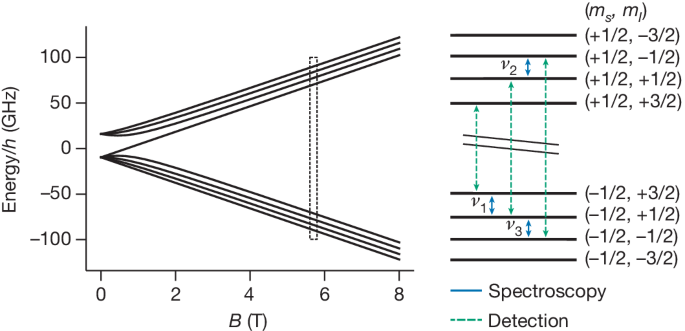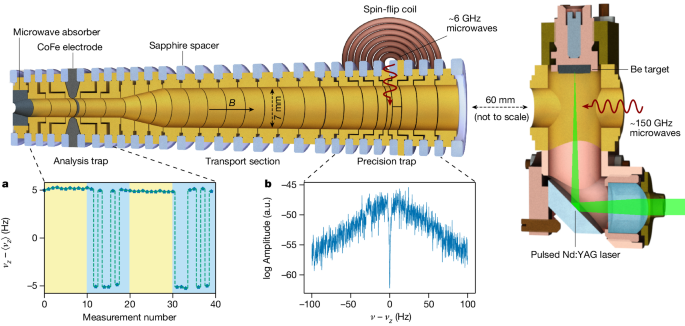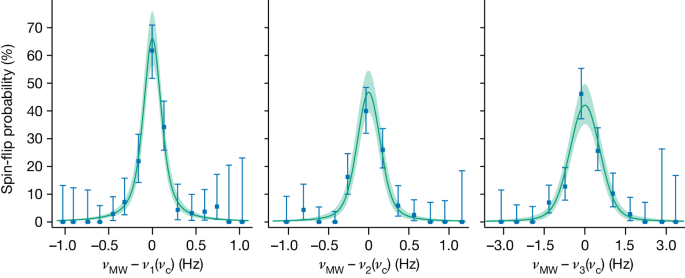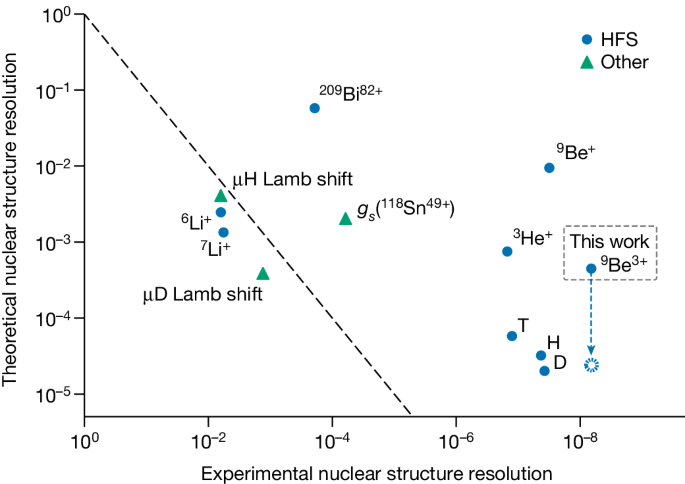Historically, advances in precision atomic spectroscopy have progressed alongside the development of the quantum theories of nature to successfully explain even the smallest of contributions to atomic transition frequencies. Meanwhile, precise tests and searches for new physics require that the established theories provide sufficiently accurate predictions for the observed system. Nowadays, in atomic systems, this frequently necessitates the knowledge of nuclear properties. However, these properties are often not known accurately enough from theoretical models describing the nuclear structure and are instead determined experimentally from independent measurements with high sensitivity to nuclear structure. For example, measurements of the Lamb shift in atomic6 or muonic hydrogen7 and deuterium8 are combined with other transitions to independently determine the proton charge radius and the Rydberg constant9. However, discrepancies between competing results remain unsolved10. Likewise, the magnetic dipoleâdipole interaction of the nucleus with the bound electrons, which results in the hyperfine splitting (HFS), depends on the magnetic moment of the nucleus and is markedly influenced by the Zemach radiusâa measure of electric and magnetic form factors of the nucleus. Here measurements of the 1s-HFS interval in hydrogen-like systems are the most sensitive to the Zemach radius and serve as ideal references to evaluate the nuclear structure effects in other HFS intervals and test the quantum electrodynamics (QED)11. However, for low nuclear charge Z, these measurements exist only for the hydrogen isotopes11 and 3He (refs.â4,12), whereas for high Z, tests of the HFS lack accurate experimental values of the nuclear magnetic moments13,14,15.
Recently, the high-precision Penning-trap measurement of the Zeeman and hyperfine splitting of 3He+ allowed us to directly measure its Zemach radius and nuclear magnetic moment4, simultaneously providing both parameters needed for precise predictions of other HFS intervals12. Moreover, the accurate value of the magnetic moment of the atom enables absolute magnetometry with hyperpolarized 3He (ref.â16). However, this requires transferring the measured nuclear magnetic moment from the hydrogen-like system to the neutral system, which involves the theoretical calculation of diamagnetic shielding parameters. In the past, inadequate calculations of these parameters have led to several discrepancies in precision physics13,17,18,19, including the recent 7Ï deviation of the HFS specific difference in 209Bi82+,80+. In these studies, the required nuclear magnetic moments were obtained from measurements using systems with complex electronic structures and calculations of shielding parameters relying on quantum chemistry codes that frequently provide no, or underestimated, uncertainties15. By contrast, for systems such as hydrogen-like and neutral 3He, these issues are remedied by the simple electronic structure, which enables diamagnetic shielding calculations using highly accurate non-relativistic quantum electrodynamics methods. Here the diamagnetic shielding parameters are calculated in a perturbative approach, and the estimated uncertainties are more than one order of magnitude better than the experimental value of the 3He nuclear magnetic moment20. However, adjustments to the non-relativistic quantum electrodynamics theory value at the same level as the experimental uncertainty were performed recently21, further motivating an experimental verification and benchmark for diamagnetic shielding calculations.
An ideal candidate to both test the diamagnetic shielding calculations and introduce a highly accurate reference for nuclear structure contributions in the hyperfine interaction is 9Be. Here the low nuclear charge of Zâ=â4 permits calculations of the highest available accuracy in the hydrogen-like system, while, simultaneously, the Zeeman and hyperfine splitting can be probed using high-precision spectroscopy in Penning traps for both the lithium-like 9Be+ and hydrogen-like 9Be3+ charge states. In this work, we present the first measurements, to our knowledge, on 9Be3+. Compared with extractions using 9Be+ (refs.â5,22), the higher accuracy of theoretical calculations possible in hydrogen-like 9Be3+ allows for markedly improved determinations of the Zemach radius as well as the magnetic moment of the bare nucleus. Furthermore, we perform a unique comparison between the experimental hyperfine and Zeeman splitting of 9Be+ and 9Be3+, which we use to eliminate the nuclear structure-dependent terms. Compared with the measurements of the hyperfine splittings of 209Bi82+,80+ (ref.â13), this allows not only testing the QED theory using the HFS specific difference but also testing calculations of multi-electron diamagnetic shielding parameters at the parts per billion (ppb) level. The latter constitutes the first precision test of the corrections to nuclear magnetic moments across different charge states.
The combined hyperfine and Zeeman interaction in 9Be3+ is described by the Hamiltonian
$$H=-\frac{1}{2{\rm{\pi }}}\frac{e}{2{m}_{{\rm{e}}}}{g}_{s}B{S}_{z}-\frac{1}{2{\rm{\pi }}}\frac{e}{2{m}_{{\rm{p}}}}{g}_{I}^{{\prime} }B{I}_{z}+{\nu }_{{\rm{HFS}}}{\bf{S}}\cdot {\bf{I}},$$
(1)
where e is the elementary charge; me and mp are the electron and proton masses, respectively; and νHFS is the hyperfine splitting. The external magnetic field B is chosen to define the z-direction as the quantization axis for the spin angular momenta of the electron S and nucleus I. In this formula, the magnetic moments of the bound electron and shielded nucleus are given in units of the Bohr and nuclear magneton using the gyromagnetic ratios (g-factors), gs and gâ²I (the prime indicates the shielding), respectively. Using the spin magnetic quantum numbers of the electron, ms, and the nucleus, mI, the level structure of 9Be3+ is shown in Fig. 1. The 12 magnetic dipole transitions can be split into six low-frequency, 5.7âGHzâ<âνâ<â7.2âGHz, nuclear spin transitions with (Îms,âÎmI)â=â(0,â1); four high-frequency, 141âGHzâ<âνâ<â181âGHz, electron spin transitions with (Îms,âÎmI)â=â(1,â0); and two high-frequency combined transitions with (Îms,âÎmI)â=â(1,â2). The highest sensitivity for the extraction of gâ²I and νHFS is reached with the measurement of the two nuclear transitions ν1âââ6.622âGHz and ν2âââ6.553âGHz (compare Fig. 1). Our determination of the magnetic field B requires the precise knowledge of the mass \({m}_{{}^{9}{\rm{Be}}^{3+}}\) of the 9Be3+ ion. As the uncertainty \(\delta {m}_{\genfrac{}{}{0ex}{}{9}{}{\rm{Be}}}/{m}_{\genfrac{}{}{0ex}{}{9}{}{\rm{Be}}}=9\times 1{0}^{-9}\) of the current accepted mass value23 would limit the extraction of gâ²I, the measurement of a third nuclear transition ν3âââ6.124âGHz was included, allowing us to independently determine the mass.
On the left, the energies of the spin states are shown as a function of the external magnetic field B. The level structure at our magnetic field (dashed box) of around 5.7âT is shown on the right. Spectroscopy is performed on the three nuclear spin transitions (blue) labelled ν1, ν2 and ν3. The three electron spin transitions (green) are used for detecting the nuclear spin state.
The measurements are performed with a single ion in the Penning-trap setup shown in Fig. 2. The setup is placed in a sealed-off vacuum chamber inside the liquid-helium-cooled bore of a 5.7-T superconducting magnet. Inside this chamber, the vacuum conditions allow for trapping lifetimes exceeding the multiple months needed for the full measurement campaign. The magnetic field confines the ion on a circular orbit with revolution frequency \({\nu }_{c}=(qB)/(2{\rm{\pi }}{m}_{{}^{9}{\rm{Be}}^{3+}})\), where νc is the cyclotron frequency and qâ=â3e is the charge of 9Be3+. The cylindrical electrodes of the trap are biased by an ultrastable voltage source to create a quadrupolar electrostatic potential, forcing the ion into a harmonic oscillation along the z-axis with frequency νz. This further splits the radial motion into two eigenmotions characterized by the modified cyclotron frequency ν+ and the magnetron frequency νâ. Here νcâââν+âââ29âMHzââ«âνzâââ480âkHzââ«âνââââ4âkHz. By measuring the three eigenfrequencies and combining them using the so-called invariance theorem, \({\nu }_{{\rm{c}}}^{2}={\nu }_{+}^{2}+{\nu }_{-}^{2}+{\nu }_{z}^{2}\), the cyclotron frequency is reproduced while cancelling certain systematic effects24. A superconducting tank circuit is connected to one of the trap electrodes to provide resistive cooling of the axial mode to the ambient 4.2âK as well as detection of the axial oscillation25 (Fig. 2). Sideband coupling to the axial mode enables thermalization and frequency measurement of the radial modes26.
The Penning trap is built up of gold-plated copper electrodes separated by isolating sapphire spacers (blue). Microwaves for driving the electron spin transitions are irradiated on-axis by a waveguide, and a coil with a few windings connected to coaxial cables is used to drive the low-frequency nuclear transitions in the precision trap. 9Be3+ ions are produced using laser ablation from a solid beryllium target and subsequent electron impact ionization. a, While alternating the irradiation of the two electron spin detection transitions (indicated by the two background colours) in the analysis trap, axial frequency jumps are observed only for one of them. b, The motional frequencies of 9Be3+ are measured by dip signals in the Fourier spectrum of the detection signal. a.u., arbitrary units.
For the spectroscopy of the spin transitions, we count spin-state changes of the ion following an excitation with a frequency close to the transition centre. Changes in the spin state are detected by using the continuous SternâGerlach effect27. To this end, a ferromagnetic ring electrode introduces a quadratic magnetic field ÎBâ=âB2z2, where B2âââ282âkTâmâ2. This couples the magnetic moment of the ion to its axial motion, slightly altering νz depending on the spin state. Changes in the spin state induced by a transition (ms, mI)âââ(mâ²s, mâ²I) lead to a shift Îνz proportional to the change of the magnetic moment27. For an electron spin transition, (Îms,âÎmI)â=â(1,â0), the axial frequency jump Îνzâââ10âHz can be easily detected. By contrast, the change of the magnetic moment of the ion for a nuclear spin transition, (Îms,âÎmI)â=â(0,â1), is greatly reduced, making its detection challenging. For instance, in the case of ν1, the axial frequency jump is only Îνzâââ6âmHz, which cannot be discerned from the background fluctuations of νz. Instead, for the spectroscopy of nuclear transitions (ms, mI)âââ(ms, mâ²I), the two detection transitions (ms, mI)âââ(mâ²s, mI) and (ms, mâ²I)âââ(mâ²s, mâ²I) are used, compare Fig. 1. While cycling these two transitions, only one of them produces detectable electron spin-state changes (Fig. 2a), which unambiguously identifies the nuclear spin state.
As the large B2 required for spin-state detection would limit the experimental precision, we use spatially separated traps for spin-state detection and the precision measurement, called analysis trap (AT) and precision trap (PT) (ref.â28) (Fig. 2). In the PT, the residual magnetic field inhomogeneity is greatly reduced, B2,PTâââ1âTâmâ2. A measurement cycle starts by determining the spin state in the AT. Following an adiabatic transport to the PT, an initial cyclotron frequency measurement νc,1 determines the expected spin transition frequency. During a second measurement of the cyclotron frequency νc,2, the spin transition is driven with a frequency νMW, which is randomly offset from the previously calculated value. After a third measurement, νc,3, the ion is transported back to the AT to again detect the spin state and determine whether it changed from the previously detected one. We measured νc to a precision of one part in a billion with typical averaging times of a few minutes and performed a single measurement cycle in 20âmin. For each of the three transitions, a few hundred measurement cycles were performed.
We use maximum likelihood estimation to fit the centre values of νMWâââνi(νcâ£Îe,âÎI,âνHFS) from the three recorded resonances shown in Fig. 3 to extract Îe, ÎI and νHFS, where
$${\varGamma }_{e}=\frac{{g}_{s}}{2}\frac{e}{q}\frac{m}{{m}_{{\rm{e}}}},\,\,{\varGamma }_{I}=\frac{{g}_{I}^{{\prime} }}{{g}_{s}}\frac{{m}_{{\rm{e}}}}{{m}_{{\rm{p}}}},$$
(2)
compare equation (1) and Supplementary Information for details. The statistical uncertainties are 17âmHz, 26âmHz and 86âmHz for ν1, ν2 and ν3, respectively. Experimental systematic shifts and uncertainties are because of special relativity effects, electrostatic and magnetostatic field imperfections, induced image charges, the axial frequency determination and the accuracy of the GPS-locked rubidium clock. Moreover, we include a second-order effect arising from the electric quadrupole moment of the nucleus29, slightly shifting the transition frequencies. A discussion of systematic effects and the error budget is provided in the Supplementary Information. The corrected results are Îeâ=ââ5479.8633435(11)(19)âHz, ÎIâ=â2.1354753854(11)(3)âÃâ10â4âHz and νHFSâ=âââ12796971342.630(50)(15)âHz, where the first number in parentheses is the statistical error and the second is the systematic uncertainty.
The difference of the probe excitation at frequency νMW to the nuclear spin transition frequency νi(νc) is calculated from the simultaneously measured νc. The data points are the binned number of successful spin-flip tries divided by the total number of tries in that bin, and the error bars correspond to the 68% binomial confidences. The line and confidence band (68%) are taken from a Voigt profile fit by maximum likelihood analysis of the unbinned data.
Both the g-factor of the free electron and of the bare nucleus need to be corrected for the influence of the binding potential in the composite system30. Our calculations of the bound-electron g-factor include corrections due to special relativity, QED, nuclear recoil and structure effects (Supplementary Information). We evaluate gs(9Be3+)â=ââ2.0017515747, where uncertainties due to uncalculated higher-order QED corrections as well as nuclear corrections are smaller than 1 in the last given digit. The binding corrections to the bare nuclear g-factor gI are expressed as gâ²Iâ=â(1âââÏ)gI, where Ï is the diamagnetic shielding parameter. The theoretical calculations of diamagnetic shielding parameters include corrections due to nuclear recoil, relativistic effects, one-loop QED and finite nuclear size effects. We evaluate Ï(9Be3+)â=â71.15397(14)âÃâ10â6 (Supplementary Information).
From ÎI, we calculate the bare nuclear g-factor using the proton-to-electron mass ratio31, our values of the bound-electron g-factor gs(9Be3+) and the shielding Ï(9Be3+). Our result, gIâ=ââ0.78495442296(42)exp(11)theo, improves the accuracy by a factor of 45 compared with the result in ref.â22, the latter being limited by the shielding parameter of 9Be+. With a fractional uncertainty of 0.6âppb, our result establishes the nuclear magnetic moment of 9Be as the second most precise, to our knowledge, surpassed only by that of the proton32. By comparisons with 9Be+, we evaluate the shielding factor of the lithium-like system,
$$1-\sigma ({}^{9}{{\rm{Be}}}^{+})=(1-\sigma ({}^{9}{{\rm{Be}}}^{3+}))\frac{{\varGamma }_{I}({}^{9}{{\rm{Be}}}^{+})}{{\varGamma }_{I}({}^{9}{{\rm{Be}}}^{3+})}\frac{{g}_{s}({}^{9}{{\rm{Be}}}^{+})}{{g}_{s}({}^{9}{{\rm{Be}}}^{3+})}.$$
(3)
This requires the experimental result of ÎI(9Be+) from ref.â5 and the bound-electron g-factor gs(9Be+)â=ââ2.0022621287(24). For the latter, we use the calculations performed in ref.â22 and the updated nuclear recoil correction33,34. We evaluate Ï(9Be+) = 141.8821(11)exp(12)theo à 10â6, where the second uncertainty is limited by gs(9Be+). The theoretical value, Ï(9Be+) = 141.85(3) à 10â6 (ref.â22), is in good agreement with our experimental result. To our knowledge, this constitutes the first high-precision test of the calculation of a multi-electron diamagnetic shielding parameter. The shielding calculations for the three-electron systems 9Be+ and 6,7Li are performed identically and use explicit values of the leading- and lowest-order recoil terms and an estimate of the relativistic correction22,33. At the current state of theoretical calculations of the lithium-like shielding parameters, we confirm the leading-order calculation and the estimate of the relativistic correction, solidifying its use for 6,7Li. In the future, the advanced calculations performed for 3He can be extended to 9Be+ (ref.â35), and our experimental value of Ï(9Be+) will serve as an ideal benchmark at the ppb precision level.
Calculations of the zero-field hyperfine splitting can be expressed as36,37,38
$${\nu }_{{\rm{HFS}}}=\frac{{E}_{{\rm{F}}}}{2h}(1+{\delta }_{{\rm{pt}}}-2Z\,{\mathop{r}\limits^{ \sim }}_{Z}/{a}_{0}),$$
(4)
where EF is the non-relativistic value of the hyperfine splitting39, a0 is the Bohr radius, δpt summarizes all corrections with a point-like treatment of the nucleus (Supplementary Information), and all nuclear structure contributions are absorbed in \(-2Z{\widetilde{r}}_{Z}/{a}_{0}\approx 6\times 1{0}^{-4}\) by the effective Zemach radius \({\widetilde{r}}_{Z}\). In comparison, the relative nuclear structure contributions to the electron g-factor gs and the shielding Ï(9Be3+) are below 10â10, which highlights the sensitivity of the HFS to effects from the nuclear structure. From our experimental result, νHFS(9Be3+)â=ââ12796.971342630(52)âMHz, we calculate the effective Zemach radius \({\widetilde{r}}_{Z}=4.048(2)\,{\rm{fm}}\). This value is consistent with that extracted from 9Be+, \({\widetilde{r}}_{Z}=4.03(5)\,{\rm{fm}}\) (ref.â36) (value corrected with our more accurate magnetic moment) and improves its accuracy by a factor of 25, which is possible because of the more accurate calculation of δpt(9Be3+) compared with δpt(9Be+).
Following investigations on 209Bi (ref.â19), we form a specific difference between the hydrogen- and lithium-like systems, ÎνHFS = νHFS(9Be+) â ξνHFS(9Be3+) to cancel the large theoretical uncertainties due to nuclear structure with the calculated weighting factor ξâ=â0.04881891046 (Supplementary Information). This complements the high-Z case of 209Bi because of the different theoretical approaches used to calculate the lithium-like HFS. For high Z, the large relativistic effects are included directly in the leading order by the use of a relativistic wave function basis set, whereas electronâelectron correlations are treated perturbatively40. By contrast, for low Z, the electronâelectron correlations lead to considerably larger contributions that require using wave functions constructed from an explicitly correlated, non-relativistic basis set, and the relativistic corrections are instead treated perturbatively41,42. Therefore, in the case of 209Bi, higher-order QED terms are tested by ÎνHFS, whereas in our study at low Z, higher-order electron correlation effects are benchmarked. The experimental result, using νHFS(9Be+) = â625.008837044(12)âMHz from ref.â43 is ÎνHFS,exp = â274.638909(12)âkHz, where the uncertainty is dominated by νHFS(9Be+). We calculate the theoretical value, ÎνHFS,theo = â271.4(3.6)âkHz, which is in good agreement with the experimental value but has a much larger uncertainty. Equivalently, this constitutes a test of νHFS(9Be+) with 6-ppm precision. Similar to calculations for 6,7Li, estimates of the QED contributions to the lithium-like system limit the accuracy of the theoretical result38.
In Fig. 4, we compare the nuclear structure resolution of several measurements. Our determination of the nuclear structure contribution to the HFS of 9Be by 9Be3+ shows leading experimental resolution and substantial improvements of the theory compared with 9Be+. This progress now enables testing other HFS systems in 9Be with higher accuracy using our precise values of the Zemach radius and the nuclear magnetic moment, as demonstrated by our evaluation of the specific difference. Furthermore, future tests of the theory of the HFS in the helium-like system 9Be2+ will benefit from our results44, and direct measurements of the 2s HFS in 9Be3+ would provide an opportunity for highly stringent tests of bound-state QED because of the more accurate theory in single-electron systems.
The y-axis is the fraction of the theoretical uncertainty of the point-nucleus calculations to the nuclear structure contribution. The x-axis is the fraction of experimental uncertainty to the nuclear structure contribution. The dashed diagonal line indicates equal experimental and theoretical resolution. For H, D and T, HFS calculations from ref.â38 were used, which, as opposed to our value for νHFS(9Be3+), do not include contributions and uncertainties from hadronic and muonic vacuum polarization as well as certain nuclear recoil terms. For comparison, the blue dashed line and point indicate the reduced theoretical uncertainty of νHFS(9Be3+) using the same calculations that do not include the aforementioned contributions. For details, see Supplementary Table 7.
Finally, we calculate the atomic mass of 9Be from Îe, using the electron mass31, the required binding energies45,46,47 and our theoretical value of gs(9Be3+). The result, \({m}_{{}^{9}{\rm{Be}}}=9.0121830344(35)\,{\rm{u}}\), is in perfect agreement with the accepted value23 and improves the uncertainty by a factor of 20.
The results are summarized in Table 1. In conclusion, our precision measurement of the bare nuclear magnetic moment and the effective Zemach radius of 9Be with hydrogen-like 9Be3+ enables tests of QED methods accessible only with accurate knowledge of these properties. At present, by comparison with measurements on 9Be+, we provide the, to our knowledge, first high-precision test of multi-electron diamagnetic shielding calculations and a 6-ppm test of the QED calculations of the lithium-like 2s HFS. High-precision Penning-trap measurements of hyperfine and Zeeman splittings, which we previously demonstrated for 3He+, are now possible for a multitude of other hydrogen-like or lithium-like ions, enabling the suppression of nuclear effects, mandatory for further applications such as spectroscopic searches for physics beyond the standard model48. Furthermore, measurements on 6,7Li2+ would enable direct comparisons with the recent measurements on the helium-like charge states21,37,49.






